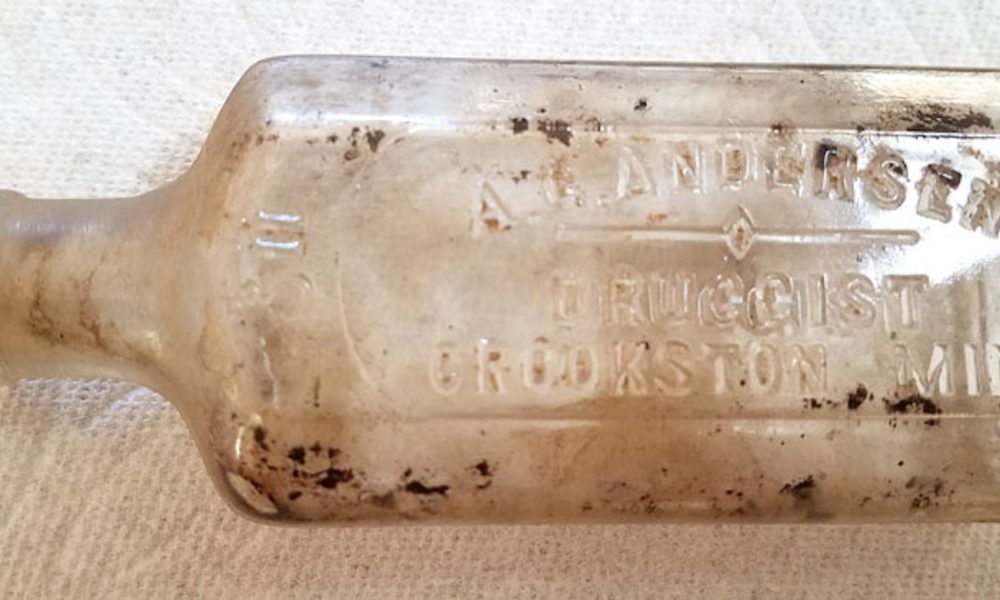 Creswell Heritage Foundation unearthed this two-ounce druggist bottle, filled with a distilled elixir, during a preliminary architect assessment of the Old Schoolhouse foundation in March. PHOTO PROVIDED
Creswell Heritage Foundation unearthed this two-ounce druggist bottle, filled with a distilled elixir, during a preliminary architect assessment of the Old Schoolhouse foundation in March. PHOTO PROVIDED
Over 100 years ago, a Creswell resident discarded a two-ounce druggist bottle filled with a distilled elixir, likely a chloroform compound for toothache, produced by A.G. Andersen, a well-regarded pharmacist with a drugstore in Crookston, Minnesota.
On March 28, 2018 Creswell Heritage Foundation’s first cultural archeological find was made during a preliminary architect assessment of the Old Schoolhouse’s foundation. The find was the druggist bottle with ”A.G. ANDERSEN, DRUGGIST, CROOKSTON, MINN.” embossed on the side of the bottle. Other symbols on the side of the bottle indicate that the bottle holds two ounces. The markings on the bottom of the bottle indicate the manufacturer of the bottle.
I have a bachelor’s in Historic Preservation, earned from the University of Oregon and so I knew exactly who to go to help date the bottle. Linda Hart at Heritage Research Associates, Inc. is an archaeologist and an expert in the identification of household archeological items. She said she was not surprised the bottle was found under the Old Schoolhouse. Often, household trash would be buried or discarded under buildings or in abandoned wells.
Based on our initial conversation, she was able to identify the maker of the bottle as Whitall Tatum & Co. when I described the markings embossed on the bottom of the bottle. When I arrived at our meeting, Hart had copies of articles and resource lists laid out for me to take and he gave me a two-hour remedial lesson on the dating of the bottle. She reminded me that it is a matter of using the clues on the bottle to rule out and narrow down the date.
The shape and marking on the front of the bottle tells us that it is a druggist bottle. We used the ”go-to” article about Whitall Tatum & Co. and the marking on the bottom to date the bottle as being made between 1901 and 1924.
There are tiny bumps at the corners of the bottle which are made by the vent holes of the metal mold that the molten glass is poured into. The more vent bumps, the newer the bottle. I counted eight bumps. The top of the bottle is a ”collared ring.” They became fashionable in 1909 but were made through 1925. We looked at many other parts of the bottle to rule out distinguishing marks made during production.
Finally, we researched A.G. Andersen to narrow down when the bottle was made and when it was used to fill his prescriptions. There was quite a bit in the archives about A.G. Andersen. In 1888, Andersen purchased his first drugstore, Norsk Drug Store, at 120 West Robert, Crookston, Minnesota. According to The Northwestern Druggist, Volume 2, in 1911, he ”added to his equipment a still for distilling medicated and other waters.”
Finally, looking at the Old Schoolhouse, it was a school until 1900 when it was sold to and moved to its current location by the First Baptist Church. The church owned it until 1926. Sometime within that time the bottle would have been discarded under the building where it lay until Creswell Heritage Foundation found it over 100 years later.
By putting the three sections together: bottle dating, 1901-1925; A.G. Andersen, 1888-1922; and the First Baptist Church, 1900-1926; we come up with an average date range of 1901 to 1922. The many vent bumps on the bottle and the collared ring of the bottle dated it to around 1909. A.G. Andersen’s distillery equipment purchase of 1911 helped with a possible date.
The bottle was likely made between 1909 and 1922 and the medication, if it was distilled, placed in the bottle between 1911 and 1922. I like to think it could be a median of 1915 when the bottle and medication found its way to Creswell.
The Old Schoolhouse is a prominent reminder of our town’s history, but it’s the little finds such as the dirty, forgotten druggist bottle that can tell a personal story about our society and the people who lived here. As we recognize May as National Historic Preservation Month, we are reminded that our history can be evidenced by a building and also a by a bottle.







